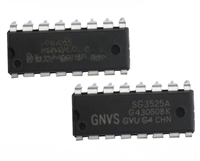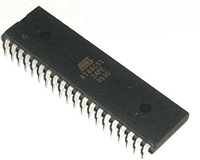hysteresis causes one input to effectively move quickly pass
the other. Thus, effectively moving the input out of region that
oscillation may occur.
Application Info
Basic Comparators
A comparator is quite often used to convert an analog signal
to a digital signal. The comparator compares an input volt-
age (VIN) at the non-inverting pin to the reference voltage
(VREF) at the inverting pin. If VIN is less than VREF the output
(VO) is low (VOL). However, if VIN is greater than VREF, the
output voltage (VO) is high (VOH).
Hysteresis can easily be added to a comparator in a
non-inverting configuration with two resistors and positive
feedback Figure 3. The output will switch from low to high
when VIN rises up to VIN1, where VIN1 is calculated by
VIN1 = (VREF (R1 + R2))/ R2
The output will switch from high to low when VIN falls to VIN2
where VIN2 is calculated by
,
LMV7251
VIN2 = (VREF (R1 + R2) - VCC R1) / R2
The Hysteresis is the difference between VIN1 and VIN2
.
∆VIN = VIN1- VIN2 = ((VREF (R1 + R2)) / R2) - ((VREF (R1 +
R2) - VCC R1) / R2) = VCC R1/ R2.
DS200057-15
LMV7255
DS200057-18
DS200057-16
Input/Output
DS200057-19
FIGURE 3. Non-Inverting Comparator Configuration —
LMV7251
For an inverting configured comparator, hysteresis can be
added with a three resistor network and positive feedback.
When input voltage (VIN) at the inverting node is less than
non-inverting node (VT), the output is high. The equivalent
circuit for the three resistor network is R1 in parallel with R3
and in series with R2. The lower threshold voltage VT1 is
calculated by:
DS200057-17
FIGURE 2. Basic Comparator
Hysteresis
VT1 = ((VCC R2) / ((R1 R3) / (R1+ R3)) + R2)
The basic comparator configuration may oscillate or produce
a noisy output if the applied differential input is near the
comparator’s input offset voltage. This tends to occur when
the voltage on the input is equal or very close to the other
input voltage. Adding hysteresis can prevent this problem.
Hysteresis creates two switching thresholds (one for the
rising input voltage and the other for the falling input volt-
age). Hysteresis is the voltage difference between the two
switching thresholds. When both inputs are nearly equal,
When VIN is greater than VT, the output voltage is low. The
equivalent circuit for the three resistor network is R2 in
parallel with R3 and in series with R1. The upper threshold
voltage VT2 is calculated by:
VT2 = VCC ((R2 R3) / (R2 + R3)) / ((R1 + ((R2 R3) / (R2 +
R3))
The hysteresis is defined as
∆VIN = VT1 - VT2 = ((VCC R2) / ((R1 R3) / (R1+ R3)) + R2) –
(VCC ((R2 R3) / (R2 + R3)) / ((R1 + ((R2 R3) / (R2 + R3)))
7
www.national.com






 SG3525资料手册详解:SG3525参数分析、引脚说明、应用介绍
SG3525资料手册详解:SG3525参数分析、引脚说明、应用介绍

 AT89C51单片机资料手册详细解析及应用示例
AT89C51单片机资料手册详细解析及应用示例

 CP2102资料手册解读:CP2102引脚说明、关键参数分析
CP2102资料手册解读:CP2102引脚说明、关键参数分析

 资料手册解读:UC3842参数和管脚说明
资料手册解读:UC3842参数和管脚说明
